
Examiners' report comments added 23 June 2014 - it took VCAA a l-o-n-g time to publish these! Post Mortem Notes This is not a VCAA publication.
I do not speak for the VCAA, the IT examiners, or exam markers. I was not involved in the writing or marking of this examination. Extracts from exams are all Copyright © VCAA, and are used with permission. Use these post mortems at your own risk. I reserve the right to change my mind completely, at short notice, about anything I've said here. Suggestions, discussions and corrections are welcome. Questions look like this. |
||
|
Other VCE IT Exam Post Mortems to enjoy IPM / ITA / Informatics / Data Analytics - 2001 | 2002 | 2003 | 2004 | 2005 | 2006 | 2007 | 2008 | 2009 | 2010 | 2011 | 2012 | 2013 | 2014 | 2015 | 2016 | 2023
|
||
Last changed:
March 9, 2022 11:34 AM
|
The Post Mortem Awards |
|||
The SCHMACKOS award is given to questions that are a complete dog's breakfast. |
 The Questions That Make You Sick As A Dog Award Questions that are not totally wrong, but are just dumb or are wrong in a way that does not jeopardise the answer. |
The exciting Illiteracy Award. |
New in 2013, the Post Mortem Stamp of Approval, for questions I like |
INFORMATION TECHNOLOGY:
|
Section |
Number of questions |
Number of questions to be answered |
Number of marks |
20 |
20 |
20 |
|
12 |
12 |
70 |
|
|
|
|
Total 90 |
Materials supplied
Instructions
At the end of the examination
Students are NOT permitted to bring mobile phones and/or any other unauthorised electronic devices into the examination room.
General Comments
Generally, responses drawing on knowledge gained from completing practical activities during the learning process were the most successful. High-scoring students had, for example, a clear understanding of the influence of design elements on the appearance of websites, and the ability to select and apply test data when developing solutions for information problems. They could also choose appropriate data types when creating tables for a relational database management system and design queries and formulas using logical conditions that returned information for specified purposes.
Where questions required extended responses, many students completed most of the task but did not address all parts of the task. For example, some students provided accurate descriptions of either a database or spreadsheet solution but failed to provide test data for the second requirement. For example, many successful responses had been divided into sections, with detailed answers set out under headings for each part of the question.
While the majority of students could design a website and annotate their design to explain the relationships between the features of their design and the requirements of the design brief (Section B, Question 11), a significant number mistakenly used their annotations to simply describe fonts, sizes and colours without explaining their purpose. With the exception of navigation, few students were able to recommend a design element related to the functionality of a website (Section B, Question 9b.).
Students and teachers are reminded that a number of key knowledge points are expressed in terms of efficiency and effectiveness. For example, they require an understanding of how particular functions or techniques increase the efficiency of collecting data (Unit 3, Outcome 2) or the ability to create criteria for evaluating the effectiveness of information management strategies (Unit 4, Outcome 2). Demonstrating an understanding of these key knowledge points involves explaining how the function or technique reduces time, cost or effort in the case of efficiency, or how a management strategy improves data integrity, security, ease of retrieval and currency of files in the case of effectiveness. It is not sufficient to simply use the words ‘efficient’ or ‘effective’.
In general, responses that provided examples taken from the context of the scenarios were the most successful.
Answer all questions in pencil on the answer sheet provided for multiple-choice questions.
Choose the response that is correct or that best answers the question.
A correct answer scores 1, an incorrect answer scores 0.
marks
will not be deducted for incorrect answers.
No marks
will be given if more than one answer is completed for any question.
When Old Time Gardeners decides to re-landscape a suburban parkland, it sets up a website so that local residents can view each stage of the construction.
This type of online community is best described as
A. social.
B. collaboration.
C. project-based.
D. knowledge-sharing.
Answer is C. But I don't like it.
Not an easy starter for 2013's exam.
The study design mentions 3 types of online communities - social, work-based and project/interest-based.
(A) is true insofar as the gardeners are communicating with society, but it's not a "get together and meet people" sort of "social" website.
(B) is not one of the 3 designated types.
(C) is a designated type, and closer to the truth than (A).
(D) is accurate in that the OTGs are sharing knowledge with local residents, but it's not one of the official 3 types.
I originally went for (D), forgetting the study design had listed the 3 official types. Sigh.
OFFICIAL RANT BEGINS
But just because the study design lists 3 types after the word "including", that does not mean that there is no such thing as a knowledge-sharing website.
What on earth is this site?
Can the OTG site not be described as 'knowledge sharing'? Is that not true? Of course it is.
Is the VCAA official answer more true just because only 3 types (out of an infinite number) are listed in the study design? I don't think so.
A project-based online community is meant to serve the people on the project - not outsiders like the local residents! Option D is actually better.
So since the aim of section A is to "Choose the response that is correct or that best answers the question.", (D) is most correct.
Perhaps the question should have been, "Of the 3 types of online community named in the study design, which most closely matches the OTG online community?"
That way, students would not accidentally choose an option that is true and accurate and get the answer totally wrong! Grrr.
But when choosing answers, kiddies, remember Mr Kelly's Golden Rule - The study design is always right.
But let's not get bogged down now in petty criticism of VCAA.
This is only question 1 ... there's plenty of time left.

No. Must relax. Rainbows and unicorns. Peace and harmony. VCAA is not the enemy...
Britney Spears and Adam Sandler are.
76% of the state got this right.
Evaluating a solution involves
A. determining the evaluation criteria.
B. testing whether the solution does what it was intended to do.
C. reporting on the extent to which the solution meets the requirements of the user.
D. determining what information the solution has to provide and what data is needed to produce it.
Answer is C.
(A) is done during design, and is a prelude to evaluation.
(B) is done during development.
(D) is done during analysis.
(C) is the only one that requires the solution to be finished before it can take place, which is when evaluation happens.
68% of the state got this right. 20% went for B.
A local library wants to update its website so that new users can easily access the online catalogue. The most suitable form of user documentation would be a
A. quick start guide.
B. table of contents.
C. technical manual.
D. Help Desk email contact.
Answer is A.
The quick start quide is appropriate for new users since they would only need enough information to get them started.
The other options are not listed in the study design (p.36) as being required, which is a clue that they would not be right, but still look them over...
A table of contents (B) does not actually give useful information... it only tells you where the information can be found.
A technical manual (C) is irrelevant to
users' needs.
An email contact (D) might be handy, but as the sole source of documentation it would be inconvenient for staff, and slow for users to get supplied with information.
71% of the state got this right. Nearly everyone else chose B.
A physical device that can help prevent unauthorised access to data and information on a network is
A. a PIN.
B. a swipe card.
C. a thumb print.
D. an encryption key.
Answer is B.
Ha! They got it right this year (considering the dog's breakfast they made of it in 2010.)
A PIN - Personal Identification Number - is data, not a physical device, as is an encryption key. A thumb print is biometric data, and while it is physical, you don't usually refer to your fingers as 'devices.'
Well, I don't anyway. My toes, however, are a different matter.
I'll give the examiners a Stamp Of Approval as an cheery encouragement award.

65% of the state got this right.
A solution developer wants to test the efficiency of using the date convention of mm/dd/yyyy for an online sales form to be used in a global market. He tracks the results of 100 users who were required to enter the current date using this convention. The best measure to indicate the efficiency of using this convention is
A. how quickly each user enters the date.
B. the percentage of users who enter complete dates.
C. the number of users who accurately enter the current date.
D. the number of error messages received by users to indicate incorrect date order.
Answer is A.
When you get a question with the words "efficiency" or "effectiveness" in them, it can be easy to eliminate options. To measure efficiency, the only option that refers to time, money, labour or ease-of-use is the issue of time/speed implied in (A).
The number of people entering complete dates is a matter of accuracy, which is an effectiveness measure.
(C) is also obviously an accuracy measure, and even uses the word "accurately".
The error messages in (D) is also a clear indicator of accuracy, so it can be also ruled out quickly.
55% of the state got this right.
Sunny Tennis Club is updating its website to attract new members. It is making decisions about what information will be available for the general public (open) and what will be for members only (closed). Which diagram represents the best decision for the club?
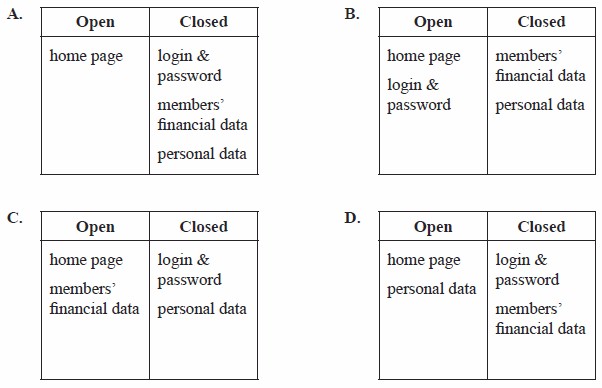
Answer is B.
Rule out (C) and (D) immediately because it's silly to have members' financial or personal data open to the public.
That leaves the question of whether "login & password" should be open to the public.
But I'm wondering what "login and password information" means in terms of a website. Does it mean that lists of users' login names and passwords are open to the public? That would be silly.
Or does it mean that a login page is open to the public - which makes sense since it has to be public so members can get into the 'closed' area of the site. I'd have to assume this one, since the alternative is dumber than a sackful of senile spaniels.
I really don't like the ambiguity of this question. Students should be assessed on their knowledge of ITA, not how well they can work out what the examiners probably meant to say.

80% of the state got this right. Nearly everyone else went for A.
Which one of the following would be a non-technical constraint on the design of a school's new website?
A. It must run on the existing classroom laptops.
B. New and existing file formats must be compatible.
C. Students' examination results and attendance reports must be kept private.
D. The size of video files used by teachers for online class presentations must be limited.
Answer is C.
That's the only option that has nothing to do with hardware or software (technical) issues.
Compatibility (A&B) and capacity (D) are technical constraints.
75% of the state got this right.
The appearance of a website can be enhanced by having
A. consistent font types.
B. important information underlined.
C. navigation buttons of different sizes.
D. minimum contrast between font and background colours.
Answer is A.
An easy one. Underlining important information on a webpage (A) is bad, since it would be confused with a hyperlink. (C) is the opposite of what you'd want. With contrast, you want the maximum, not the minimum.
66% of the state got this right.
Use the following information to answer Questions 9–11.
The design for an online form to collect financial data from customers is shown below.
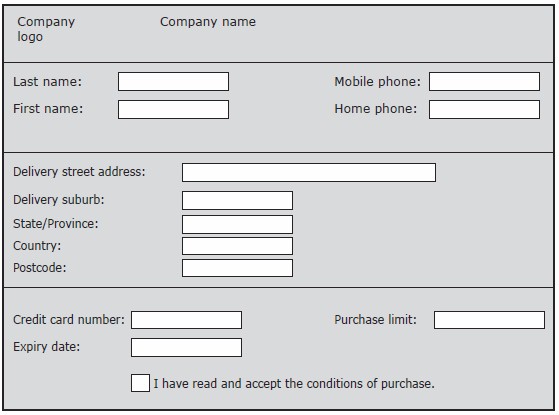
What is the best data type for the box labelled 'I have read and accept the conditions of purchase'?
A. text
B. image
C. number
D. Boolean
Answer is D.
Again, pretty easy - assuming you know that Boolean fields can only store true/false data.
86% of the state got this right.
A security protocol to protect the privacy of individuals entering their data on this form would be
A. stating a shipping and returns policy.
B. encrypting all data before it is communicated.
C. banning users who exceed their purchase limit.
D. accepting orders only from customers who tick the acceptance box.
Answer is B.
Another easy one. Encryption is the only option that actually protects data from misuse.
And since when does any payment form ask users to enter their purchase limit? This is off-world logic.
75% of the state got this right.
Which one of the following is the best validation technique for the Country field?
A. a range check
B. an input mask
C. a required field
D. a dropdown box
Answer is D.
I really don't know about this one.
To start off by eliminating the obvious, an input mask (B) is used to ensure the formatting of input data (e.g. of a credit card number) is correct - the dashes are in the right places, characters are text/numeric where they should be, et cetera. This is inappropriate for a text field such as Country.
A range check (A) usually applies to a numeric datum to check that it is within acceptable limits. But a range check could also mean that data is contained within a limited list of options, so it could apply in this case.
(C) is a bit odd. "A required field" is hardly a 'technique', but let's ignore poor expression for a minute. Making the Country field required would make sense if the organisation had foreign customers: the question does not specify whether it does or not. Making it a required field, would ensure a value was entered, but it would not check that it was a legitimate country. So it's not as valuable as A or D, which do force users to enter a valid item.
In (D), a "dropdown box" is another rather quaint examiner term, like the "drop list" they used in the in question A12 in 2008. Most people talk about dropdown lists or menus, not boxes. But let's assume they meant one of those... A dropdown list or menu is a way of enforcing selection from a limited list of acceptable options (see above), even though choosing a country from a list of approximately 200 items is rather frustrating. (You can see it in action in eBay's 'Advanced Search' page, under 'Location'.)
So, in brief, it could be (A) because it could restrict input data to those that match an item existing in a limited list.
It won't be (B), so cross that out.
(C) is a validation technique, but options A and D provide the same service, but offer more value.
(D) is a control that
enforces option (A) and additionally stops the user free-typing, which is always a good idea.
So let's say (D).
I wish the examiners would stick to standard names for input controls!
70% of the state got this right. 21% chose C.
Use the following information to answer Questions 12 and 13.
The local cinema holds a monthly mini-festival, where the owner chooses a famous director and screens a selection of their movies. To assist with matching directors and movies, the owner has decided to create a relational database management system (RDBMS) based on the following tables.
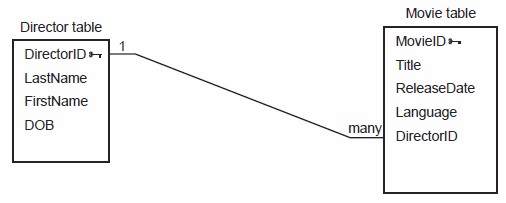
The primary key in the Movie table ensures that
A. a movie has a unique identity.
B. a director has a unique identity.
C. two directors cannot have the same LastName.
D. a director cannot be credited with the wrong movie.
Answer is A.
Students would need to recognise that after the names "DirectorID" and "MovieID" was this symbol...

means that the field is a primary key for that table. However, when printed at about 11 points in an exam the symbol is very obscure. The version shown above was only obtained after zooming the PDF of the exam in to 800% !
The primary key field (or fields) of a table is used to uniquely distinguish each record in that table from all of the other records in that table. This is why your parents gave their children different names, unlike in the Newhart TV show, where one character always introduced himself with "Hi, I'm Larry; this is my brother Darryl, and this is my other brother Darryl."
The primary key is usually an account number or arbitrary ID that can be generated by the organisation and guaranteed to be unique, unlike names or other real personal data.
Let's walk through the answer.
-
Option (B) relates to the Director table, not the Movie table referred to in the question. However it is true that the DirectorID field uniquely identifies each director in the Director table.
- It would be unreasonable to expect that no two directors in the history of cinema can have the same LastName, so (C) can be eliminated without knowing anything about primary keys. Thank Dog for common sense.
- It would be beyond the scope of a database to prevent a data entry person crediting a director with the wrong movie. I could tell a database that Fred Smith directed Spongebob Squarepants Goes Mental - and how could the database challenge me unless it was equipped with artificial intelligence and a link to IMDB? So common sense eliminates another option!
And yes, I do hope they make Spongebob Squarepants Goes Mental. I really do.

75% of the state got this right.
The relationship the owner has created between the primary key in the Director table and the foreign key in the Movie table is needed if fans using the website want to
A. sort the movies in order of release date.
B. search for all directors born in the 20th century.
C. sort the directors' last names in alphabetical order.
D. search for movies in a particular language by a director.
Answer is D.
A relationship between tables allows the looking up of related data: in this case, the connection between a particular director and a list of movies. A single table gives information about one topic, such as directors, without reference to related information, such as their movies. So, you can find their last names (C) and dates of birth (B) without a relationship to another table.
To sort movies by name (A), you don't need related information about
their directors, so that's not it.
The only option that draws data from both tables is (D)... you need the Director table to get the director's name, and the Movie table to find the language of the director's movies.
58% of the state got this right. 27% chose C.
Analysing the needs of an online community involves
A. determining what results are expected from test data.
B. monitoring users' complaints about the existing system.
C. observing the results of sample data used to test the new system.
D. interviewing community members to determine evaluation criteria.
Answer is B.
I nearly said (D) because common sense says that interviewing members directly focuses on finding out what the community believes would make their site successful.
But, determining evaluation criteria - according to VCAA's definition in the study design, page 16 - occurs during the design phase of the Problem Solving Methodology, not during analysis - the phase specified in the stem of the question - so we have to rule out the superior method of conducting interviews.
We can eliminate Options (A) and (C), which are about testing, which comes well after analysis. This leaves (B).
I've said it before and I'll say it again - why can't evaluation criteria be determined during analysis where solution requirements are determined?
53% of the state got this right. 28% chose D.
New employees use photocopy USER IDENTITIES from 999 to 1999. Test data to display an 'INVALID USER IDENTITY' message would be
A. 998 and 2000
B. 1000 and 1998
C. 999 and 1999
D. 999 and 1998
Answer is A.
998 and 2000 are both invalid data, so they would test both ends of the 'invalid spectrum'.
The other options do not test any invalid data: all of those values are valid
91% of the state got this right.
The primary purpose of a proxy server is to
A. keep an organisation's network secure.
B. forward data between computer networks.
C. connect multiple devices together to act as a single network.
D. accept requests from clients seeking resources from other servers.
Answer is D.
Most home users think of a proxy server as a cache for recently-downloaded web files, but to be technically accurate, a proxy acts as a go-between when clients seek resources from other servers. Most proxies are now web proxies.
Proxies have several other functions, including caching of files, keeping clients anonymous, auditing user requests, scanning traffic for malware, blocking undesired sites etc.
42% of the state got this right. 32% chose A.
The primary purpose of a proxy server is to accept requests from clients seeking resources from other servers. This statement describes the relationship between servers. The proxy server is smart; its primary purpose is to identify and send requested resources to other servers.
A business with more than 100 employees tests its disaster recovery strategy by simulating a fire and power failure. A criterion to evaluate the effectiveness of the strategy to protect the integrity of customer data would be to ask
A. can the back-up copies of customer data be quickly accessed?
B. is the customer data restored within 30 minutes of power returning?
C. are all back-up copies of customer records up-to-date and complete?
D. are all appropriate software companies contacted within 60 minutes?
Answer is C.
This is the twin sister of question 5 above. The key word is 'effectiveness', so you should know what to look for in the options.
Options (A) (B) and (D) are all about speed, which is an efficiency measure.
Only (C) refers to effectiveness measures - quality, accuracy etc.
You can answer this question with no knowledge of disaster recovery.
81% of the state got this right.
When a medical clinic in country Victoria implements its new information system, the managers select and delete all the patient files from the hard disks before donating the old computers to the local primary school. In doing this, the managers have
A. done all that is required under the Health Records Act 2001.
B. prevented a threat to confidential data by unauthorised users.
C. not met their legal obligations under the Health Records Act 2001.
D. followed the correct procedure for the disposal of data under the Information Privacy Act 2000.
Answer is C - but a judge could rule against me. I don't like it.
The IPA only applies to Victorian state government departments and agencies, so rule out (D).
(B) probably really should refer to people damaging original data rather than seeing copies of the data.
They are subject to the HRA, so, it comes down to the requirements of the Health Records Act.
Have they met their legal obligations or not?
Section C, part A says an object of the act is to "require responsible handling of health information in the public and private sectors". In the Health Privacy Principles, Principle 4, "Data Security and Data Retention", it requires that "An organisation must take reasonable steps to protect the health information it holds from misuse and loss and from unauthorised access, modification or disclosure."
This is where it gets argumentative. The clinic "deleted all the patient files from the hard disks before donating the old computers."
So choose one of the following:
a. Deleting the data was Good. That's reasonable. Choose option (A).
c. They failed to wipe the disks, so deleted files could be undeleted. That's unreasonable. Choose option (C).
What are "reasonable steps" in this case? My opinion is that it would be reasonable to expect a competent medical clinic to be aware of the risks of simply deleting files without wiping them. So I go for (C).
This question, I believe, is unreasonable. This should not have been a Multiple Choice question, since it requires justification of the answer, and more than one option could be rationally argued for. It would take a judge to listen to arguments from counsel about what is 'reasonable' in this case.

46% of the state got this right. Everyone else went nearly equally for the 3 other options.
The managers have not met their legal obligations under the Health Records Act 2001 when disposing of patient data. Selecting and deleting the patient files from a hard disk does not ensure the data cannot be recovered. The managers should have overwritten the data in the files before donating the computers to a school. They could have used software designed to do this.
Use the following information to answer Questions 19 and 20.
A designer setting up an RDBMS for a medical clinic prepares the following entity-relationship (ER) diagram to represent the relationships between a Patient, Doctor, Diagnosis, Medication and Appointment.
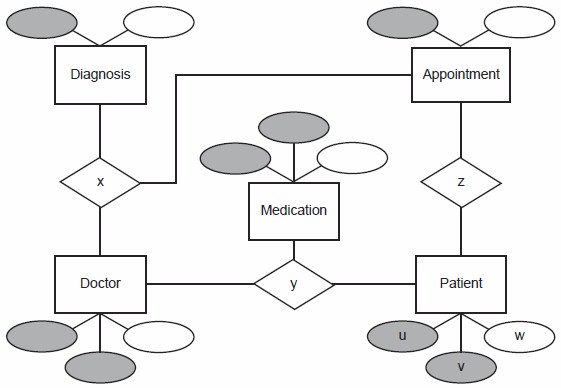
In which position would PatientID be best represented?
A. u
B. v
C. w
D. z
Answer is C.
This is really getting on my wick. This format of a Chen-style ERD is solely based on an example given in VCAA's sample ITA questions published in 2010. Nowhere are the colour codings explained. What does the grey shading mean exactly? We have to interpret that it indicates a key field. Why? Because the sample ERD has ID fields in its white elipses. Where is this explained? How are students meant to deduce that key knowledge from the 2010 sample question?
And if the colour coding is in fact some sort of official rule mandated by the precedent of the sample question, the exam question itself has violated it because in the sample questions, entities are black with white text: in the exam question, entities are white. Is that significant in some mysterious way?
These VCAA ERDs are home-grown interpretations of Chen-style ERDs, with no industry-standard authority to them that I can find. Even if they appear in a textbook, it's inadequate: texts are non-canon, and non-compulsory - and not always correct, come to think of it.
Asking specific questions about an arbitrary format is, I think, unfair.
So... students have to decide that position W is correct because (compared to U and V) its colouring is special, so it must be a special sort of field, which means it is probably a key field. Not sensible.
Now curious about ERD formats, I noticed that the sample 2010 question had a credit to conceptdraw.com, so I went there to find what wisdom they have about ERD symbols and meanings... there was no indication there about the meanings of shadings, but they did show various cardinality indicators which VCAA ERDs completely and sadly lack.
So let's compare VCAA's sample ERD...
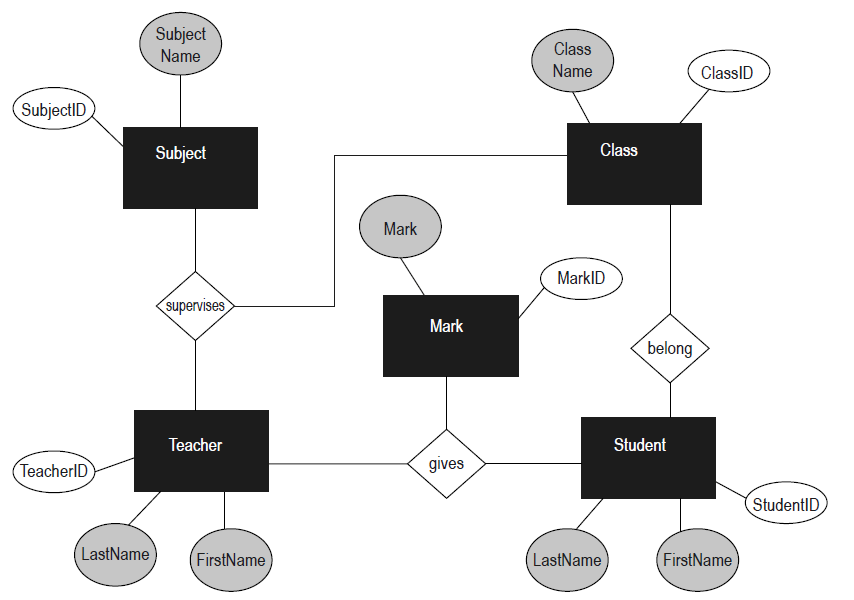
with the one from conceptdraw.com, using Chen's notation...
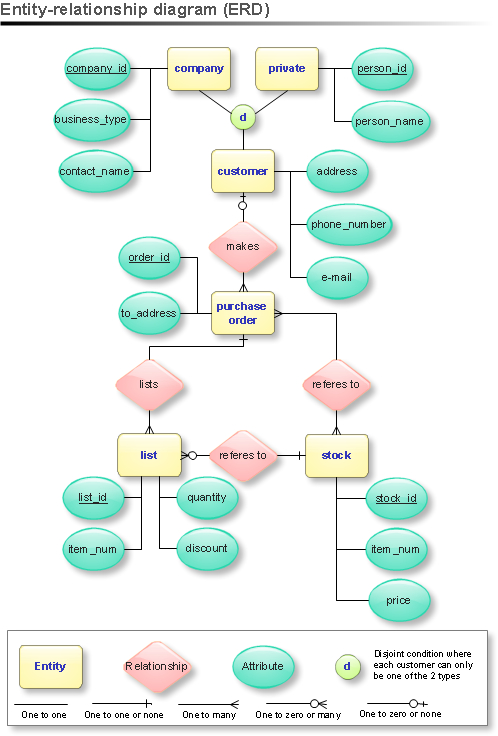
Nope. No special colour coding of key fields in there... key fields are underlined. They also provided a handy legend to explain the formatting conventions used, which VCAA should have done in their 2010 example. But they can't spell "refers". Never mind.
So let's visit Wikipedia's page on ERDs... where we also find that Chen-style primary key attributes are underlined, not colour coded.
So I'm wondering what industry-standard source of knowledge gives VCAA the confidence to ask questions about the colour scheme of a home-made diagram type that has not been explained anywhere that I can discover in IT Applications documentation or in The Real World ™?
VCAA can reply here... I'm very curious to know, because all of this bolding is hurting my CTRL+B fingers.

64% of the state got this right. 21% went for D.
What does position 'y' represent?
A. MedicationID
B. doctor gives patient medication
C. doctor diagnoses patient's condition
D. name of medication given to patient
Answer is B.
It's not an attribute - at least VCAA obeys that shape rule. So it's not (A).
Diagnosis (C) is shown at the top-left corner of the diagram, so this section won't be related to diagnosis.
The name of the medication (D) would be one of the attributes stemming from the Medication entity.
64% of the state got this right.
END OF SECTION A
SECTION B - Short answer questions[x lines] indicates how many ruled lines were provided on the paper for the answer |
|||||||||||||||||||||||||||||||||||||||||||||||||||
Answer all questions in the spaces provided. |
|||||||||||||||||||||||||||||||||||||||||||||||||||
|
(3 marks) |
Question 1 (3 marks) a. State one purpose of the Spam Act 2003. 1 mark [2 lines] Any of these will do:
Average mark 0.6/1. (60%) Successful responses indicated that the Spam Act 2003 aimed to stop unwanted emails sent by a business. Examples included ‘to prevent unsolicited commercial emails’, ‘to stop companies sending emails to people who don’t want them’, ‘make businesses provide an unsubscribe button for people on their email list’ or ‘prevent businesses using address-harvesting software to send bulk emails’. b. Give one example of an online social protocol. Explain its purpose. 2 marks [3 lines] Any of these...
There are hundreds of others. Just be sure to explain its purpose if you expect both marks. Average mark 1/2. (50%) Most students could identify an online social protocol; for example, ‘You must not use capital letters (uppercase text) because it’s considered to be shouting’. However, many students did not explain the purpose of the protocol; for example, ‘Shouting will frighten some users and stop them from giving their point of view’. |
||||||||||||||||||||||||||||||||||||||||||||||||||
|
(4 marks) |
Question 2 (4 marks) A wedding photographer wants to place the images from each couple's wedding on his website so that the couples can select the images they want for their albums. The photographer wants to ensure that the images cannot be viewed or stolen by unauthorised users, or accidentally deleted by his staff.
Suggesting the setting up of a VPN would probably be over-the-top in this case. Average mark 3.3/4. (83%)
|
||||||||||||||||||||||||||||||||||||||||||||||||||
|
(5 marks) |
Question 3 (5 marks) The owner of a business that sells flower seeds to plant nurseries has decided to create a website with an online order form, believing it will improve her business. a. Explain two ways in which the decision could increase sales. 4 marks [8 lines]
Average mark 2.8/4. (70%) b. Identify one benefit of direct data entry by customers. 1 mark [2 lines]
Just be sure not to say the same thing for (a) and (b). If you ever find you are repeating yourself, something is probably wrong. Average mark 0.7/1. (70%) |
||||||||||||||||||||||||||||||||||||||||||||||||||
|
(2 marks) |
Question 4 (2 marks) A large game development company is creating a multi-player online game to meet the needs of online gamers. The company wants its website to have a members-only section to support its collective identity. accessibility - navigation - structure - usability Explain how each would suit the needs of online gamers. [Each explanation got 2 lines of writing space.] Accessibility Players with disabilities, such as colour-blindness, poor muscular coordination, poor vision etc would find the site easier to use. Navigation Being able to go to different parts of the site with minimal confusion. clicking and page-loading will save members time and increase their visiting pleasure because they won't get lost as much or have to click as often. A simple example is having the site logo always being a link to the homepage; and having a "Back to the top" link at the bottom of each page. Structure Organising a site logically makes it easier for members to intuit where they should go to find desired resources, for example having the site divided principally by the different games on offer lets a player easily choose where to go to find information relevant to the game he/she plays. Usability A site that is easy to use saves the user time and frustration when seeking particular resources. For example, one site might require a click on an item to go to a download page where another click is required to start the download. Another more usable site would create a direct download link on the first page where the item appears. The word "two" in the instructions was not bolded, which is odd. Average mark 1.2/2. (60%) |
||||||||||||||||||||||||||||||||||||||||||||||||||
|
(5 marks) |
Question 5 (5 marks) A travel firm has upgraded to a new, networked, online sales system in each of its three offices. a. Describe how an online tutorial and content-sensitive help would each assist a staff member with using the new system. 2 marks • online tutorial [5 lines] A tutorial is a self-paced, step-by-step teaching tool which explains operations and demonstrates how they are done, often providing quizzes or revision to test learning. A tutorial would help staff members who are beginners and need to learn the system from the basics. • content-sensitive help [5 lines] This provides information based on the user's current behaviour and status. For example if they have a picture selected, the content-sensitive help would offer help on working with pictures. This type of help is useful for trained users who need relevant help as they use the system. Average mark 1.4/2. (70%) b. Justify your preferred user documentation on the basis of efficiency. 3 marks [8 lines] There are arguments for providing both help systems; choosing between them is silly since they are meant to provide very different services. It's like asking a gardener whether she would want a shovel or a rake. The key to this question is to discuss only time (speed), cost, labour, and ease of use. Anything else is effectiveness and therefore irrelevant. The very possibility that only one type of documentation is required is unrealistic. Average mark 1.6/3. (53%) |
||||||||||||||||||||||||||||||||||||||||||||||||||
|
(5 marks) |
Question 6 (5 marks) The receipt shown below is provided by BestFood supermarket as a transaction record.
A number of formats have been used to enhance the effectiveness of this receipt. a. Identify one format and explain how it has been used to enhance the receipt's effectiveness. 2 marks [3 lines]
Average mark 1.5/2. (75%) b. State three steps the developer could follow to test that the receipt provides accurate information. 3 marks [5 lines]
Average mark 2/3. (67%) |
||||||||||||||||||||||||||||||||||||||||||||||||||
|
(6 marks) |
Question 7 (6 marks) Harry manages a business that hires out fishing boats. The business has eight boats. Harry keeps records of the number of hours that each boat is hired. Each boat has a captain who is paid an hourly rate of $20 for a four-person boat and $30 for a six-person boat. A sample of the records and the data table that Harry keeps is shown below. Boat and Captain data table
Harry has normalised the data so that each field cannot be divided any further. This is shown below. Boat and Captain data table revised
a. Normalise this data into two tables so that each non-key field is fully dependent on a key field (2NF). 4 marks [33% of a page was given for the answer] Just to show my working, I started with Version 1, the logical solution...
Then I thought that adding the CaptainID field would be unnecessary if each boat had only one captain, so I thought of Version 2, which avoided the creation of the new CaptainID field...
But the Captain_Table now has no single key field - the CaptainLastName+CaptainFirstName together would have to act as a key. And since the question said that "each non-key field is fully dependent on a key field" (not "a key" which could comprise more than one field) I decided to settle on Version 1 after all. Maybe I was reading too much into the question? This solution assumes that each captain only has one boat, since the question says that "Each boat has a captain". If not, the schema would get a lot messier! Also note that each boat only appears once in the sample data, suggesting that the "Boat Hours" figure is a running total, rather than the number of hours of a single voyage. This implies to me that you do not need a "Voyages" table to record multiple voyages and that the total hours are just updated in that single field. Average mark 1.6/4. (40%) b. Explain why this process would be important to Harry's boat-hire business. [3 lines] 2 marks Actually, since there is a simple 1:1 relationship between boats and captains, the 2NF normalisation is actually of minimal value - actually, it's unnecessary. However, if a captain could work on several boats, the benefit would be greater since changes to boat or captain information could be done once in only one table rather than in several different places. Or if each individual booking of a boat needed to be recorded, a relational database would be needed. With refernce to Harry, it would be important because it would make the management and future development of his database easier, and (if it actually needed more than a 1:1 relationship) the database would be faster and smaller. Normalisation is important because it
I can appreciate that the examiners were trying to make the normalisation question easier this year, for which they get the Stamp Of Approval.
The problem is that by making the schema so simple that it did not need a 1 to many relationship, it scuttled the value of normalisation, which was the whole point of the exercise. Average mark 0.9/2. (45%) |
||||||||||||||||||||||||||||||||||||||||||||||||||
| Question 8 (6 marks) |
Question 8 (6 marks) Nancy is the administrator at Melbourne City Secondary College, a government school. She has been asked to sell archived students' details to a marketing company. If Nancy does sell these details, she intends to use the money to buy sports equipment for the school. a. Identify key legislation that must be considered before Nancy decides whether or not to pass on the students' details. 1 mark [2 lines]
This is a tricky one. I am not at all sure whether Victorian government schools are classified as being part of the Victorian Public Service, which would invoke the IPA. I've checked the IPA Act and am none the wiser because schools are not mentioned. Is a state school "a body established or appointed for a public purpose by or under an Act" or "a public sector agency"? I sure as hell don't know, and I doubt that ITA kids would or should know either. I'm pretty sure Victorian state schools would not be subject to the Privacy Act, but I imagine many big ones could turn over more than $3 million a year. So they might be. How big is Melbourne City SC? I've written to the Privacy Commissioner to get some clarification on this one. 11 November - the Privacy Commissioner's office has replied and confirmed that state schools ARE subject to the IPA. This greatly affects part (c). I wish the examiners would choose an organisation whose legal status was very, very clear and stay away from these murky special cases. Average mark 0.5/1.. (50%) b. Explain Nancy's ethical responsibilities to the students and Melbourne City Secondary College. 2 marks [6 lines] To Students - protect their physical and emotional wellbeing, and protect their personal information from disclosure or misuse. The question does not focus on her responsibilities regarding student data. To list her ethical responsibilities in general would be irrelevant and very verbose. It needed more precise wording. Students here need to notice the question has two parts, and they should address both the students and the college. Average mark 1.2/2. (60%) c. Recommend a strategy to help Nancy resolve the ethical dilemma. 3 marks [7 lines] What ethical dilemma? She is bound by the IPA (according to the Privacy Commissioner's Office), so she has a legal responsibility not to sell student data, so there is no ethical issue. It's like asking whether it's ethical to murder someone: you have no choice in the matter. The law dictates what is right and wrong. Ethics don't enter into it! This question causes more of a dilemma than Nancy ever faced. Let's assume for a moment that the question is bad, and they examiners want students to talk about Nancy having to decide whether to sell student data for the sake of money for sports gear. In that case, you'd compensate for the bad question and go on about... - Nancy must decide which is better: to sell student data and possibly adversely affect students' privacy; or to not sell the data and not be able to buy the sports equipment which would benefit the students. Dare I suggest that she impose sanctions upon herself to teach herself a lesson? This is not a good question.
Average mark 1.4/3. (47%) |
||||||||||||||||||||||||||||||||||||||||||||||||||
|
(8 marks) |
Question 9 (8 marks) Pine Industries, a timber company, is considering two different designs for its new website. The home page must contain the title, a logo, links to five major sections, a copyright statement and options for a range of other languages. Pine Industries hopes to raise community awareness of its environmental projects. The two designs have been prepared and are shown below. design 1
design 2
a. Select one design element related to appearance from those listed below. consistency orientation contrast Explain how this design element has been used in each design to enhance the appearance of the Pine Industries website. 4 marks Again, the number "one" in the question was not bolded on the paper. selected design element: consistency use in design 1 [4 lines]
use in design 2 [4 lines]
selected design element: orientation use in design 1 [4 lines]
use in design 2 [4 lines]
selected design element: contrast use in design 1 [4 lines]
use in design 2 [4 lines]
Average mark 2.9/4. (73%) In design 2, reverse blocking in the navigation bar (white text with black background) contrasts with the black text on white background for the remainder of the website. Accepted answers for the design element of orientation included the use of either vertical (design 1) or horizontal (design 2) navigation links that complemented other design features. For consistency, students typically referred to font type and size, explaining that changes in font size appropriately matched the hierarchy of information; for example, the largest font size was allocated to the name of the organisation, with the copyright statement being in the smallest font size. b. Recommend and justify your preferred home page design based only on functionality. Your response must make reference to two design elements that are related to functionality. 4 marks [8 lines]
Note how I used dotpoints for the answer - it makes life easier for you and the exam marker because you are well aware of where different points beginning and end, and the marker can see you can differentiate between ideas. The study design's glossary defines functionality design elements as "structure, usability and accessibility, including navigation and load time, appropriateness and relevance." Did anyone prefer design 1? I predict that most students did not know what the functionality design elements were, and just repeated what they said in part A of the question. Average mark 1.7/4. (43%) |
||||||||||||||||||||||||||||||||||||||||||||||||||
|
(10 marks) |
Question 10 (10 marks) Fruit First wants to take orders online and manage its sales effectively. Examples of Worksheet and Data table designs that the manager can use are shown below. Worksheet
Data table
Hang on a spaniel-slapping minute - what does "QuantitySoldPerKg" mean? Does it mean the number of kilograms sold of each fruit, or the number or each fruit that constitute a kilogram?
Indicate with a tick one software type that your answers will refer to. spreadsheet (SS) a. Explain how the manager could SPREADSHEET OPTION • report on sales trends for each fruit
But 'sales trends' usually refer to sales over time. The data has only one data point for each fruit. How can you show trends with a single data point? That's why I answered 'bar chart' instead of 'line graph'. It does not make much sense to me, unless the examiners meant to say "Sales figures" instead of "Sales trends."
• identify the fruits that have had more than 500 kg in sales OK. What does "identify" mean in this context? "Find and Isolate"? "Highlight"? The question is too vague to mandate a strict answer.
• test that the solution operates as intended.
RDBMS OPTION • report on sales trends for each fruit Well, this is a problem. Does MS Access do charts? I have no idea. I know that Filemaker didn't create charts up until very recently. Perhaps student could cheat and say "Create a chart..." and dare the examiner to guess what make and model of RDBMS they used for their SACs. Without chart functionality (as my kids last year would have been), you'd have to say something like...
Any other suggestions?
• identify the fruits that have had more than 500 kg in sales Well, again we have fun. Filemaker has had conditional formatting functionality for a couple of versions now. I can't speak for MS Access. Again, kids could just repeat the spreadsheet answer and dare the examiner to prove them wrong. The only alternative would be...
• test that the solution operates as intended.
Average mark 2.8/6. (47%) b. Using the software that you selected in part a., answer the following questions. i. Describe how the manager can identify and display on a web page the cheapest fruit available. 2 marks [5 lines] "display on a web page"? Do the examiners want students to come out with something as trite as "Open a web page editor, create or load the web page, type in the number, save the page and upload it with FTP"? That really would be a waste of a year of study. Or do the examiners expect student to explain how to extract the data from a spreadsheet or database, feed it into a webpage with PHP, SQL, Cold Fusion or whatever and display it? I'll be spanked with a saucy sausage dog if I could explain how to do it. Either way, the answer will either be trivially simple, or monstrously difficult.
To identify the cheapest fruit is a different matter, but not much easier if you think about it. FEEDBACK Laurie suggested using VLOOKUP, which was a good idea. This would work... Roland suggested GoogleDocs spreadsheet with the security pegged at a public view setting for putting the value on a web page. SPREADSHEET The dumbest, but probably expected answer is: The manager should: Is that really what the examiners were after? Or did they want something like... - Sort the fruits in acending order by the PricePerKg column so the cheapest fruit appears at the top. I only hope they accept variations of answers for their vague and impossible question. RDBMS - Create a calculated field (Filemaker) or an expression in a query with the formula MIN(PricePerKg) and display the value in a report. Average mark 0.9/2. (45%) ii. Recommend a format or convention that the manager could apply when displaying the cheapest fruit to the user. 2 marks [5 lines] Use a leading dollar sign, then the price with 2 decimal places. Really - they gave 5 lines of writing for that? What else could one say? Black Arial 12 point? Average mark 1/2. (50%) |
||||||||||||||||||||||||||||||||||||||||||||||||||
|
(9 marks) |
Question 11 (9 marks) Healthy Cooking is an online community where users can share information about cooking for a healthy lifestyle. a. Design a screen mock-up for a new forum page that meets Healthy Cooking's need to • provide an identity for the site
b. Annotate your design with explanations to show how it has met these three user needs. 3 marks [Half a page blank for the answer to parts a and b] There are many approaches to achieving this - here is one attempt. Yours would probably want to be less frivolous, 'cos the examiners tend to be Very Serious People who don't seem to appreciate levity.
The main thing is that you try to provide something that looks like a standard webpage, with conventional adornments such as logos, large heading, underlined links, login/password combinations, Privacy policy/Contact links etc. 11a - Average mark 3.9/6. (65%) The design below is a compilation of examples taken from many successful responses. The design shown features a padlock symbol next to the ‘Shop’ link, indicating a secure payment process. There were many other successful responses. Some, for example, included a shopping trolley symbol and/or the word ‘PayPal’ in their design.
11b - average mark 1.7/3. (57%) |
||||||||||||||||||||||||||||||||||||||||||||||||||
|
(7 marks) |
Question 12 (7 marks) Kelly is a writer who keeps a data table of the images that she uses in each of the 12 chapters of her new book. The table has the following field names. FileName, Chapter, FileFormat, Description, FileSize When she sorts the Chapter field of her data table, she gets the following result. a. Explain why this happens. 2 marks [3 lines] Because she has defined the Chapter field as being of type TEXT, the chapter names are being sorted purely as text with no recognition of the value of the position of the numerical digits. In that way, "12" comes before "2" because the digit 1 is alphabetically before the digit "2". This is the same knowledge as was tested in ITA 2011, question A13. I still think its domain is more SD than ITA. Only 13% of kids got it right in 2011. I wonder how many will get it right this time... Average mark 1/2. (50%) b. Recommend a procedure that Kelly could follow to ensure chapters are displayed in the correct numerical order. Explain how she could test the procedure. 3 marks [6 lines] Fixing: Insert leading zeroes as place-holders, such as Chapter01. Notice how the question had two parts to it and my answer was very clearly divided into two parts as well. Don't mix one answer up in another as a large amorphous blob and give the impression you can't tell the difference between them. B11b was a very trivial question, in my opinion. A bloke off the street could have guessed that one without a year's intensive study IT. Average mark 1.4/3. (47%) c. Kelly wants to list all of the GIF-formatted images (.gif) that are less than 50 KB. She should create a query/find of this sort: Average mark 0.9/2. (45%) |
||||||||||||||||||||||||||||||||||||||||||||||||||
|
END OF QUESTION AND ANSWER BOOK |
Back to the IT Lecture Notes index
Back to the last page you visited
Created 5 November 2013
Last changed: March 9, 2022 11:34 AM
VCE Applied Computing Notes © Mark Kelly 2001-
Original Content © Mark Kelly 2013
Images and questions © Victorian Curriculum
and Assessment Authority 2013.
Reproduced here with permission.